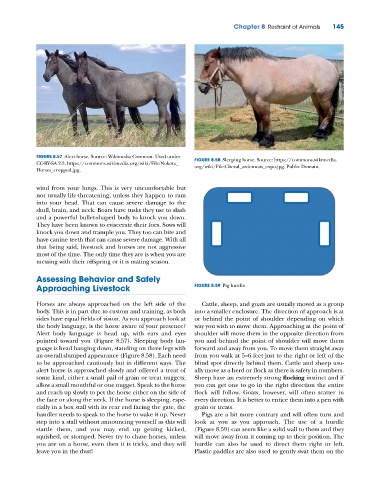Page 161 - Zoo Animal Learning and Training
P. 161
Chapter 8 Restraint of Animals 145
FIGURE 8.57 Alert horse. Source: Wikimedia Common. Used under
CC‐BY‐SA 2.5, https://commons.wikimedia.org/wiki/File:Nokota_ FIGURE 8.58 Sleeping horse. Source: https://commons.wikimedia.
Horses_cropped.jpg. org/wiki/File:Cheval_ardennais_expo.jpg. Public Domain.
wind from your lungs. This is very uncomfortable but
not usually life‐threatening, unless they happen to ram
into your head. That can cause severe damage to the
skull, brain, and neck. Boars have tusks they use to slash
and a powerful bullet‐shaped body to knock you down.
They have been known to eviscerate their foes. Sows will
knock you down and trample you. They too can bite and
have canine teeth that can cause severe damage. With all
that being said, livestock and horses are not aggressive
most of the time. The only time they are is when you are
messing with their offspring or it is mating season.
Assessing Behavior and Safely
Approaching Livestock FIGURE 8.59 Pig hurdle.
Horses are always approached on the left side of the Cattle, sheep, and goats are usually moved as a group
body. This is in part due to custom and training, as both into a smaller enclosure. The direction of approach is at
sides have equal fields of vision. As you approach look at or behind the point of shoulder depending on which
the body language, is the horse aware of your presence? way you wish to move them. Approaching at the point of
Alert body language is head up, with ears and eyes shoulder will move them in the opposite direction from
pointed toward you (Figure 8.57). Sleeping body lan- you and behind the point of shoulder will move them
guage is head hanging down, standing on three legs with forward and away from you. To move them straight away
an overall slumped appearance (Figure 8.58). Each need from you walk at 5–6 feet just to the right or left of the
to be approached cautiously but in different ways. The blind spot directly behind them. Cattle and sheep usu-
alert horse is approached slowly and offered a treat of ally move as a herd or flock as there is safety in numbers.
some kind, either a small pail of grain or treat nuggets; Sheep have an extremely strong flocking instinct and if
allow a small mouthful or one nugget. Speak to the horse you can get one to go in the right direction the entire
and reach up slowly to pet the horse either on the side of flock will follow. Goats, however, will often scatter in
the face or along the neck. If the horse is sleeping, espe- every direction. It is better to entice them into a pen with
cially in a box stall with its rear end facing the gate, the grain or treats.
handler needs to speak to the horse to wake it up. Never Pigs are a bit more contrary and will often turn and
step into a stall without announcing yourself as this will look at you as you approach. The use of a hurdle
startle them, and you may end up getting kicked, (Figure 8.59) can seem like a solid wall to them and they
squished, or stomped. Never try to chase horses, unless will move away from it coming up to their position. The
you are on a horse, even then it is tricky, and they will hurdle can also be used to direct them right or left.
leave you in the dust! Plastic paddles are also used to gently swat them on the

